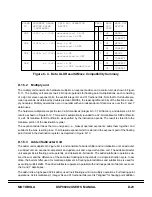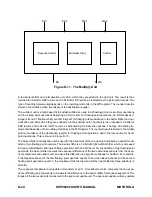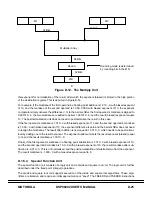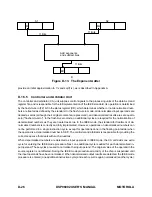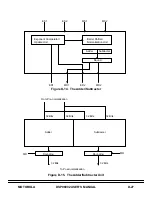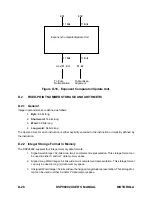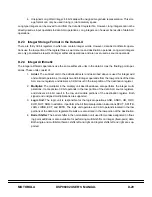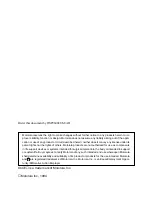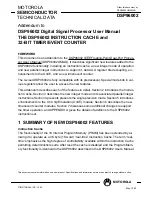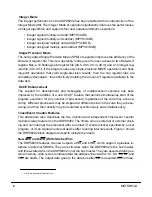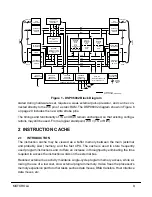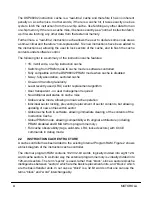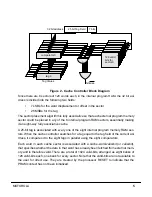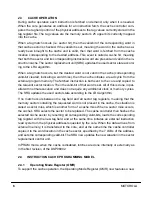
6
MOTOROLA
2.3
CACHE OPERATION
During cache operation each instruction is fetched on demand, only when it is needed.
When the core generates an address for an instruction fetch, the cache controller com-
pares the tag field portion of the physical address to the tag values currently stored in the
tag register file. The tag values are the memory sector’s 25 upper bits currently mapped
into the cache.
When a tag match occurs (i.e. sector hit), then the valid-bit of the corresponding word in
that cache sector is checked. If the valid-bit is set, meaning the word in the cache has al-
ready been brought to the cache and is valid, then that word is fetched from the cache
location corresponding to the desired address. This event is called a cache hit, meaning
that both the sector and its corresponding instruction word are present and valid in the in-
struction cache. The sector replacement unit (SRU) updates the used sector state accord-
ing to the LRU algorithm.
When a tag match occurs, but the desired word is not valid in the cache (corresponding
valid-bit cleared, indicating a word miss), then the cache initiates a read cycle from the
external program memory. The fetched instruction is both sent to the core and copied to
the relevant sector location. Then the valid-bit of that word is set. All of this is done in par-
allel with normal execution and does not require any additional clock or memory cycles.
The SRU updates the used sector state according to the LRU algorithm.
If no match occurs between the tag field and all sector tag registers, meaning that the
memory sector containing the requested word is not present in the cache, the situation is
called a sector miss, which is another form of a cache miss. When a sector miss occurs,
the cache’s SRU selects the sector to be replaced. The cache controller then flushes the
selected cache sector by resetting all corresponding valid-bits, loads the corresponding
tag register with the new tag field, and at the same time initiates an external instruction
read cycle from the physical address requested by the core. When the data arrives from
external memory, it is transferred to the core, and at the same time the cache controller
copies it to the word location in the cache sector, specified by the 7 LSBs of the address,
and sets the corresponding valid-bit. The SRU now updates the new situation in the sector
replacement control unit.
In PRAM mode, when the cache is disabled, fetches are done internally or externally as
in the first revision of the DSP96002.
2.4
INSTRUCTION CACHE PROGRAMMING MODEL
2.4.1
Operating Mode Register (OMR)
To support the cache operation, the Operating Mode Register (OMR) now features a new
Summary of Contents for DSP96002
Page 3: ...1 2 DSP96002 USER S MANUAL MOTOROLA ...
Page 38: ...MOTOROLA DSP96002 USER S MANUAL 3 15 Figure 3 4 Modulo Arithmetic Unit Block Diagram ...
Page 39: ...3 16 DSP96002 USER S MANUAL MOTOROLA ...
Page 53: ...4 14 DSP96002 USER S MANUAL MOTOROLA ...
Page 76: ...MOTOROLA DSP96002 USER S MANUAL 5 23 Figure 5 8 Address Modifier Summary ...
Page 86: ...6 10 DSP96002 USER S MANUAL MOTOROLA ...
Page 101: ...MOTOROLA DSP96002 USER S MANUAL 7 15 Figure 7 9 HI Block Diagram One Port ...
Page 140: ...7 54 DSP96002 USER S MANUAL MOTOROLA ...
Page 166: ...9 10 DSP96002 USER S MANUAL MOTOROLA ...
Page 181: ...MOTOROLA DSP96002 USER S MANUAL 10 15 Figure 10 8 Program Address Bus FIFO ...
Page 337: ...MOTOROLA DSP96002 USER S MANUAL A 149 ...
Page 404: ...A 216 DSP96002 USER S MANUAL MOTOROLA PC xxxx D ...
Page 460: ...A 272 DSP96002 USER S MANUAL MOTOROLA SIOP Not affected ...
Page 484: ...A 296 DSP96002 USER S MANUAL MOTOROLA SSH PC SSL SR SP 1 SP ...
Page 519: ...MOTOROLA DSP96002 USER S MANUAL A 331 ...
Page 718: ...MOTOROLA DSP96002 USER S MANUAL B 199 ...
Page 871: ... MOTOROLA INC 1994 MOTOROLA TECHNICAL DATA SEMICONDUCTOR M Addendum ...
Page 888: ...MOTOROLA INDEX 1 INDEX ...
Page 889: ......


